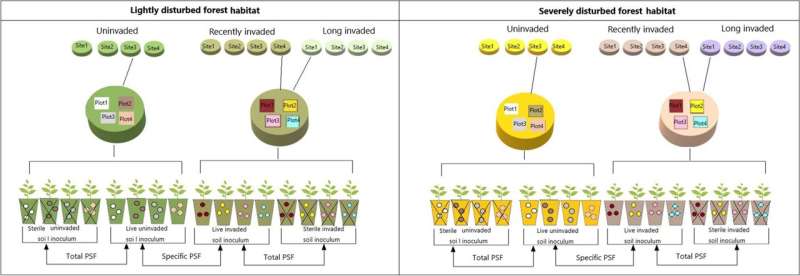This article has been reviewed according to Science X's editorial process and policies. Editors have highlighted the following attributes while ensuring the content's credibility:
fact-checked
trusted source
proofread
Researchers investigate effect of invasive species on plant–soil microbial feedback in different environments

Interactions between plants and their associated soil biota (plant-soil feedback, PSF) are often considered to be one of the most important drivers of plant abundance, community composition, and biological invasion. However, it is still unclear how PSF changes during biological invasions in different environments.
In a study published in Plant and Soil, researchers from the Xishuangbanna Tropical Botanical Garden (XTBG) of the Chinese Academy of Sciences sought to determine whether and how the dominance, ecological impacts, PSFs, soil nutrients and microbes change for Ageratina adenophora (a noxious invasive perennial weed) during its invasion processes, their casual relationships, and whether they differ among different habitat contexts.
The researchers measured aboveground biomass and cover of the invasive plant Ageratina adenophora, richness and diversity of its co-occurring native plants, PSFs for the invader, soil nutrients, and fungal communities at uninvaded, recently and long-invaded sites in lightly and heavily disturbed habitats.
They found that invasion time and habitats influenced PSFs for the invader interactively. As invasion time increased, the positive total PSFs (response to their soil biota relative to sterilized soil) shifted to neutral, and the negative specific PSFs (response to their own soil biota relative to other species' soil biota) became stronger in lightly disturbed habitats, but not in severely disturbed habitats.
The intensity and direction of both total and specific PSFs experienced by the invader during the initial phase of invasion varied across different habitats, and the direction of change also differed. These changes may contribute to changes in the dominance and ecological impact of A. adenophora at invasion sites.
"Our results suggest that the complex spatiotemporal dynamics of PSFs may contribute to the dynamics of dominance and impact of invasive species in forests. In studying PSFs, the effects of invasion time and environment should be considered," said Li Yangping of XTBG.
More information: Yang-Ping Li et al, Temporal dynamics of plant−soil feedback and related mechanisms depend on environmental context during invasion processes of a subtropical invader, Plant and Soil (2023). DOI: 10.1007/s11104-023-06380-1
Provided by Chinese Academy of Sciences




















